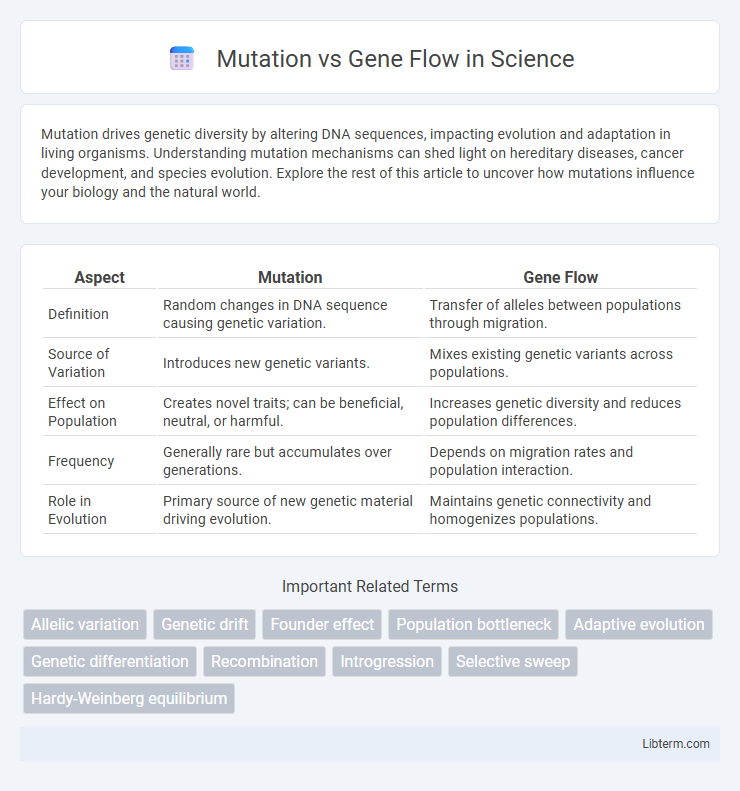Mutation drives genetic diversity by altering DNA sequences, impacting evolution and adaptation in living organisms. Understanding mutation mechanisms can shed light on hereditary diseases, cancer development, and species evolution. Explore the rest of this article to uncover how mutations influence your biology and the natural world.
Table of Comparison
| Aspect | Mutation | Gene Flow |
|---|---|---|
| Definition | Random changes in DNA sequence causing genetic variation. | Transfer of alleles between populations through migration. |
| Source of Variation | Introduces new genetic variants. | Mixes existing genetic variants across populations. |
| Effect on Population | Creates novel traits; can be beneficial, neutral, or harmful. | Increases genetic diversity and reduces population differences. |
| Frequency | Generally rare but accumulates over generations. | Depends on migration rates and population interaction. |
| Role in Evolution | Primary source of new genetic material driving evolution. | Maintains genetic connectivity and homogenizes populations. |
Introduction to Mutation and Gene Flow
Mutation is a fundamental genetic process that introduces new alleles into a population's gene pool by altering DNA sequences, creating genetic variation essential for evolution. Gene flow involves the transfer of alleles between populations through migration, promoting genetic diversity and reducing differences among populations. Both mechanisms play crucial roles in shaping genetic structure and evolutionary dynamics within and between populations.
Defining Mutation: The Source of Genetic Variation
Mutation is a change in the DNA sequence that introduces new genetic variations by altering nucleotides, insertions, deletions, or duplications within a gene. It acts as the original source of genetic diversity by generating novel alleles that can be passed on to subsequent generations. Gene flow, in contrast, involves the transfer of existing genetic material between populations, reshaping allele frequencies without creating new genetic variants.
Understanding Gene Flow: Movement of Genetic Material
Gene flow involves the transfer of genetic material between separate populations, increasing genetic diversity and reducing differences caused by isolation. This process occurs through the migration of individuals or the dispersal of gametes, which introduces new alleles into a gene pool. Mutation creates new genetic variations within a population, while gene flow redistributes existing alleles across populations, influencing evolutionary dynamics.
Mechanisms of Mutation in Populations
Mutation mechanisms in populations primarily involve changes in the DNA sequence caused by errors during DNA replication, exposure to mutagens, or spontaneous chemical changes such as deamination. These alterations result in new alleles that introduce genetic diversity essential for evolution and adaptation. Mutations can be point mutations, insertions, deletions, or chromosomal rearrangements, with varying effects on population genetics and fitness.
Processes Driving Gene Flow Between Populations
Mutation introduces new genetic variants by altering DNA sequences, creating the raw material for evolution. Gene flow transfers these genetic variants across populations through migration or interbreeding, increasing genetic diversity and reducing population differentiation. Processes driving gene flow include dispersal of individuals, pollen or seed movement in plants, and human-mediated transport, which facilitate allele exchange and impact evolutionary dynamics.
Comparative Impacts on Genetic Diversity
Mutation introduces new genetic variants by altering DNA sequences, serving as the primary source of genetic novelty within populations. Gene flow, the transfer of alleles between populations through migration, increases genetic diversity by introducing existing genetic variants from other populations. While mutation generates unique alleles at a slower rate, gene flow rapidly homogenizes genetic variation across populations, thereby reducing genetic differentiation.
Mutation vs Gene Flow: Evolutionary Significance
Mutation introduces novel genetic variations by altering DNA sequences, serving as the primary source of genetic diversity necessary for evolution. Gene flow, the transfer of alleles between populations through migration, homogenizes genetic differences and can introduce new alleles that enhance adaptive potential. Both processes are crucial for evolutionary dynamics, with mutation generating raw material for selection and gene flow shaping population genetic structure and facilitating adaptation to changing environments.
Examples Illustrating Mutation and Gene Flow
Mutation introduces new genetic variants, such as the sickle cell allele in humans arising from a point mutation, which can influence traits like malaria resistance. Gene flow occurs when populations exchange genes, exemplified by the movement of alleles between neighboring populations of European butterflies, increasing genetic diversity. Both processes shape population genetics by either creating novel alleles or distributing existing alleles across populations.
Role in Adaptation and Speciation
Mutation introduces new genetic variants by altering DNA sequences, serving as the fundamental source of genetic diversity crucial for adaptation and speciation. Gene flow transfers existing alleles between populations, homogenizing genetic differences and potentially impeding speciation by reducing reproductive isolation. While mutation drives novel traits essential for adapting to changing environments, gene flow can either facilitate adaptation by spreading beneficial alleles or constrain speciation by maintaining genetic connectivity.
Conclusion: Interplay of Mutation and Gene Flow in Evolution
Mutation introduces new genetic variants by altering DNA sequences, serving as the primary source of genetic diversity within populations. Gene flow redistributes these variants across populations, enhancing genetic homogeneity and counteracting the effects of genetic drift and local adaptation. The interplay of mutation and gene flow shapes evolutionary trajectories by balancing novel variation generation with the spread and maintenance of alleles, ultimately influencing species' adaptability and genetic structure.
Mutation Infographic

 libterm.com
libterm.com